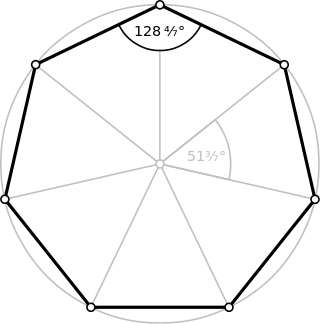In mathematics, particularly abstract algebra, an algebraic closure of a field K is an algebraic extension of K that is algebraically closed. It is one of many closures in mathematics.

In mathematics, a field is a set on which addition, subtraction, multiplication, and division are defined and behave as the corresponding operations on rational and real numbers do. A field is thus a fundamental algebraic structure which is widely used in algebra, number theory, and many other areas of mathematics.
In mathematics, a finite field or Galois field is a field that contains a finite number of elements. As with any field, a finite field is a set on which the operations of multiplication, addition, subtraction and division are defined and satisfy certain basic rules. The most common examples of finite fields are given by the integers mod p when p is a prime number.
In mathematics, a profinite group is a topological group that is in a certain sense assembled from a system of finite groups.
In mathematics, a global field is one of two types of fields which are characterized using valuations. There are two kinds of global fields:
Field theory is the branch of mathematics in which fields are studied. This is a glossary of some terms of the subject.
In field theory, a branch of algebra, an algebraic field extension is called a separable extension if for every , the minimal polynomial of over F is a separable polynomial. There is also a more general definition that applies when E is not necessarily algebraic over F. An extension that is not separable is said to be inseparable.
In algebra, a field k is perfect if any one of the following equivalent conditions holds:
Chebotarev's density theorem in algebraic number theory describes statistically the splitting of primes in a given Galois extension K of the field of rational numbers. Generally speaking, a prime integer will factor into several ideal primes in the ring of algebraic integers of K. There are only finitely many patterns of splitting that may occur. Although the full description of the splitting of every prime p in a general Galois extension is a major unsolved problem, the Chebotarev density theorem says that the frequency of the occurrence of a given pattern, for all primes p less than a large integer N, tends to a certain limit as N goes to infinity. It was proved by Nikolai Chebotaryov in his thesis in 1922, published in.
In Galois theory, the inverse Galois problem concerns whether or not every finite group appears as the Galois group of some Galois extension of the rational numbers . This problem, first posed in the early 19th century, is unsolved.
In mathematics, specifically the algebraic theory of fields, a normal basis is a special kind of basis for Galois extensions of finite degree, characterised as forming a single orbit for the Galois group. The normal basis theorem states that any finite Galois extension of fields has a normal basis. In algebraic number theory, the study of the more refined question of the existence of a normal integral basis is part of Galois module theory.
In number theory, Hilbert's irreducibility theorem, conceived by David Hilbert in 1892, states that every finite set of irreducible polynomials in a finite number of variables and having rational number coefficients admit a common specialization of a proper subset of the variables to rational numbers such that all the polynomials remain irreducible. This theorem is a prominent theorem in number theory.
In mathematics, a field F is called quasi-algebraically closed if every non-constant homogeneous polynomial P over F has a non-trivial zero provided the number of its variables is more than its degree. The idea of quasi-algebraically closed fields was investigated by C. C. Tsen, a student of Emmy Noether, in a 1936 paper ; and later by Serge Lang in his 1951 Princeton University dissertation and in his 1952 paper. The idea itself is attributed to Lang's advisor Emil Artin.
This is a glossary of arithmetic and diophantine geometry in mathematics, areas growing out of the traditional study of Diophantine equations to encompass large parts of number theory and algebraic geometry. Much of the theory is in the form of proposed conjectures, which can be related at various levels of generality.
In mathematics, a field is pseudo algebraically closed if it satisfies certain properties which hold for algebraically closed fields. The concept was introduced by James Ax in 1967.
In mathematics, the field of definition of an algebraic variety V is essentially the smallest field to which the coefficients of the polynomials defining V can belong. Given polynomials, with coefficients in a field K, it may not be obvious whether there is a smaller field k, and other polynomials defined over k, which still define V.
In mathematics, field arithmetic is a subject that studies the interrelations between arithmetic properties of a field and its absolute Galois group. It is an interdisciplinary subject as it uses tools from algebraic number theory, arithmetic geometry, algebraic geometry, model theory, the theory of finite groups and of profinite groups.
In mathematics, the Haran diamond theorem gives a general sufficient condition for a separable extension of a Hilbertian field to be Hilbertian.
In mathematics, the Hasse invariant of an algebra is an invariant attached to a Brauer class of algebras over a field. The concept is named after Helmut Hasse. The invariant plays a role in local class field theory.

Moshe Jarden is an Israeli mathematician, specialist in field arithmetic.



